Museums and Exhibitions in New York City and Vicinity
| Home | | Museum Guide | | International | | Architecture & Design | | Theater |
GLENN LONEY'S MUSEUM NOTES
CONTENTS, June 1, 2000
[01] Royal Treasures of Ur at Morgan Library
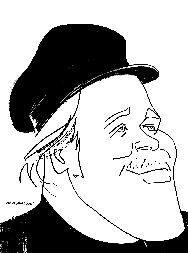
Caricature of Glenn Loney
by Sam Norkin.
[02] Met Renovates Velez Blanco Patio
[03] Met's Century of Design: Part II/1925-1950
[04] Met's American Modern, 1925-1940
[05] David Smith on Met Roof
[06] KAIKODO: Asian Art Sanctuary
[07] Russian "Painting Revolution" in Phoenix
[08] William Merritt Chase at BMA
[09] Maxfield Parrish at BMA
[10] Frank Ghery's New Guggenheim on East River
[11] Guggenheim's "1900: Art at the Crossroads"
[12] "In the Footsteps of Goethe" at Dahesh
[13] Give Dahesh the Huntington Hartford Gallery!
You can use your browser's "find" function to skip to articles on any of these topics instead of scrolling down. Click the "FIND" button or drop down the "EDIT" menu and choose "FIND."
For editorial and commercial uses of the Glenn Loney INFOTOGRAPHY/ArtsArchive of international photo-images, contact THE EVERETT COLLECTION, 104 West 27th Street, NYC 10010. Phone: 212-255-8610/FAX: 212-255-8612.
Copyright © 2000 Glenn Loney.
For a selection of Glenn Loney's previous columns, click here.
SUMMER FARE:
At the Morgan Library—
Treasures from the Royal Tombs of Ur
[Closing September 10]

| |
| LION HEAD FROM ROYAL TOMBS OF UR--On view at Morgan Library. | |
The major summer show at the Morgan is one of these: Remarkable golden jewelry and treasure from the Royal Burials at Ur of the Chaldees.
But even these have a direct connection to the Morgan Collections.
J. P. Morgan was fascinated by—and collected—the small incised cylinder seals used by ancient Sumerians near the confluence of the Tigris & Euphrates Rivers. These were rolled onto damp clay tablets as royal or official authentication.
Some impressive examples of this small-scale Mesopotamian imagery were found in the Tombs of Ur. But by far the most impressive artifacts in the current show are the splendid ornaments and vessels created for royal and noble men and women.
Notably those found in the tomb of a royal lady known as Puabi. To see her head and ear ornaments arrayed as she might have worn them in life is most impressive.
The genius of modern jewelers such as Tiffany, Cartier, and Van Cleef and Arpels had unknown exemplars as long ago as 2600 BC! But they worked more simply and with simpler materials, such as semi-precious stones, rather than sprays of diamonds.
In the 1920s, Sir Leonard Wooley and his staff excavated a royal cemetery at Ur, containing some 1,600 burials. It was concealed beneath many layers of flood mud, silted over millennia.
Unearthed by Wooley—on expeditions jointly sponsored by the British Museum and the University of Pennsylvania Museum of Archaeology and Anthropology—the artifacts in the current exhibition are only a small part of UP's division of these treasures.
Not only dead Queens were buried in full regalia, but also their hand-maidens and household staffs as well. They were ritually sacrificed to accompany their mistresses into the next world, where, presumably, they would continue to serve them.
One hopes that the splendid beads, gowns, and ornaments which adorned these beautiful young women—just before they were murdered—were some compensation for their ordeal?
For centuries in the Ancient World, being chosen as a servant of an exalted person—especially an old one—was not only a great honor, but a certain guarantee of a premature death.
And not only in Babylon or Memphis!
To be chosen Aztec Beauty Queen must have been a big thrill: Miss Mexico City! Or Señorita Teoatihuacan? Wow! All Right!
Until the priests cut out your living heart with obsidian knives! To ensure a good crop of corn…
In the Ancient World—Old and New—to be especially well-formed and handsome was a Virtual Death Warrant! The volcano is rumbling? Let's throw a virgin into the bubbling crater!
At least the later pharaohs figured out that every royal death meant a drastic reduction in household staff. Not to mention the tremendous cost of the ritual slaughter of bulls, sheep, goats, and even cats and falcons to feed or entertain the Royal Dead in the Hereafter.
That's why you can see all those amusing small Nile boats laden with foodstuffs and crowded with servants at the Met Museum. Clay models of real people and food would do just as well.
Why shouldn't spirits find symbolic foods even more digestible than embalmed bulls and clay cows?
At least we have learned from the past: we don't bury people with their TVs or laptops. Not even small copies of them! There is no TV in Heaven anyway.
Unfortunately, we also do not bury our dead with anything like the splendor of the Kings and Queens of Ur.
When some future Wooley digs up the corpses—or what's left of them—at Forest Lawn a thousand years from now, he won't find any diamond tiaras or feathered capes. The undertakers have probably filched the rings and watches afer they closed the coffins anyway.
Also On View at the Morgan:
Saint-Exupéry's "Little Prince"
[Closing August 20] In 1942, the French author-aviator, Antoine Saint-Exupéry, wrote the much beloved children's book, "The Little Prince," on Long Island. Now on view are some of the drawings, notes, and sketches he made for this world-famous book.
Sacred Songs: Illuminated Choir Books
[Closing October 15] The Morgan Library has one of the world's largest and finest collections of medieval manuscripts and bound books. These choir books are the largest of such books in size and weight—and often they are also the most impressive in the splendor of their illuminations.They were made very large so that the entire cathedral or church choir could read the notes and latin texts from a single book.
In the current small but rich exhibition, the heaviest and largest of the volumes is the so-called Geese Book—with a fox conducting a chorus of geese in a border illumination. It weighs 85 pounds!
Unfortunately, in later centuries—when such lavishly illustrated vellum manuscripts were no longer in use—collectors often razored out the most lovely of the golden illuminations for framing, discarding the remainder of the page.
Some of the finest of these on display have been restored to their surviving pages. But it's still painful to see the slits were the razors or the knives once slashed them out from their temporal and spiritual homes. Often this cutting was not even carefully done.
Re-opened at the Met Museum—
[Permanent Installation]
The Renaissance Velez Blanco Patio
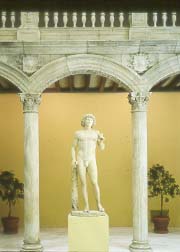
| |
| VELEZ BLANCO PATIO REBORN AT THE MET MUSEUM. | |
Fortunately, the palace patio was purchased by the Met Museum's former President, George Blumenthal, in 1913. He installed it in his Park Avenue home, later bequeathing it to the Met.
It was set up in a courtyard space—leading to the Thomas Watson Library at the Met—in 1964. Over the years, however, it has had its share of wear and tear.
Shortly before it was closed to the public for extensive renovations, I witnessed streams of water gushing from some burst pipes above the ornamental ceiling tiles of its upper balcony. Obviously, something needed to be done—and quickly.
It has taken three years, but the space and its decorations look better than ever. There are also six elaborately carved wooden friezes from the original castle, temporarily mounted on the balcony walls.
Three friezes represent the Triumph of Julius Caesar. The other three depict the Labors of Hercules. Even with the erosions of time and carelessness, these are not to be missed.
These friezes were removed, along with the courtyard, from the Castle of Velez Blanco when it was abandoned to the elements in the 19th century.
Curiously, however, they disappeared from view early in this century. In fact, they were donated to the Louvre in 1905. But they remained unopened in unmarked crates until rediscovered in 1994, in the Musée des Arts Décoratifs.
This coming January, the six astonishing wood-sculptures must return to their Paris home.
For nine decades, French state museum curators didn't even know they had the friezes—and therefore did not miss exhibiting them. So it would seem a gesture of Paris-New York amity to permit the Met to retain them on permanent loan.
Also at the Met Museum—
Century of Design, Part II: 1925-1950
[Closing October 29] Some Americans, such as Charles and Ray Eames, are included in this small but shrewdly selected show of a generation of modern design. As well as some Europeans who emigrated to America.But it is primarily about Europeans and European design influences. It uses the date of the now celebrated 1925 Paris Exposition des Arts Décoratifs et Industrieles as its point of departure.
This World's Fair of Design gave us the name Art Deco—which thereafter in America was applied to almost every modern design or object devised up to the Second World War.
In Paris, however, the Art Deco elegance of the cabinets of Émile-Jacques Ruhlmann, the stunning glassware of René Lalique, the ornamental grills of Edgar Brandt, was viewed as distinctively at its peak in the 1920s. Of course, these artists and other famous talents continued working into the 1930s.
But new influences of Modernism, Futurism, Constructivism, and the Bauhaus were superseding the Art Deco focus on delicacy of design and detail. In favor of practicality and functionality: Form Follows Function.
Among other artist-designers included are Eric Mendelsohn, Gunnar Asplund, Walter Gropius, Marcel Breuer, Alvar Aalto, Mies van der Rohe, Gerrit Rietveld, Eileen Gray, Charlotte Perriand, and Eva Zeisel.
American Modern, 1925-1940:
[Closing January 7, 2000]
Design for a New Age
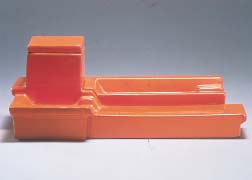
| |
| EVA ZEISEL'S ORANGE ART DECO INKWELL--Featured at Met Museum in survey of Modern Design between Wars. | |
If the 1925 Paris "Art Deco" Exposition was a watershed for new European concepts in architecture, design, and ornament, America's innovations were not anywhere to be seen. Today, this seems a scandal.
Even then, some Americans were outraged that America was not to be represented. The Republican Herbert Hoover—the man whose choice it was to participate or not—turned down the French organizers' offer of a prime pavilion site.
Hoover was, of course, a mining-engineer, not a designer nor an artist.
He asked advice of some of the nation's leading art-critics and experts. Their rueful judgment was that our architects, designers, and artists were still too much in thrall to European schools and masters. They believed we didn't have very much to show that wouldn't look like borrowings from l'École de Beaux Arts or the School of Munich.
Apparently, Frank Lloyd Wright and other distinctive American originals were beneath their exalted horizons.
But this 1925 oversight proved a stimulus to a wide variety of innovations in architecture, industrial design, interior design, appliances, textiles, ceramics, furniture, glassware, posters, and patterns.
Many of these innovations—until the end of the Great Depression and the inception of World War II—were generally classified as Art Deco. And they still are on this side of the Atlantic.
In Paris, however—as the Eurocentric exhibition above makes clear—Art Deco had reached its stylistic zenith by 1925. What followed was often described as Moderne. As it was in Britain, as well.
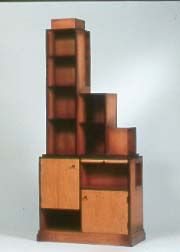
| |
| PAUL FRANKL'S ART DECO "SKYSCRAPER" BOOKCASE--At Met Museum, in showcase of American Designers from 1925 to 1940. | |
But they still qualify as Art Deco over here. As do such items as the "blue radio" and the smart Kodak camera & case of Walter Dorwin Teague.
Also on view in this show are objects and designs of Paul Frankl, Donald Deskey, Henry Dreyfuss, Russel Wright, and Raymond Loewy.
These are all silvery, with occasional scriggles of the burnishing wheel to add interest to flat surfaces. None of these is rusted, as are some David Smith outdoor sculpture classics.
They also make great Photo-Ops for tourists. But they will be removed when the bad weather begins. In the meantime, you can take the air, take a photo, and buy a cooling drink on the roof. The drinks are on the house, so to speak.
This gallery is named Kaikodo. But it does not proclaim itself a gallery from its exterior. In fact, its pristine white facade looks like Post-Modernist Bauhaus, possibly the townhouse of some fabulously wealthy Upper East Sider.
Its equally severe white interior—warmed by light-toned woods—and ingeniously designed spacious spaces make it seem a marvelous make-over of an historic townhouse. And that it what it is—from Brownstone to Bauhaus to Our House.
But to Howard and Mary Ann Rogers—who also have Kaikodo galleries in Tokyo and Hawaii—it is much more than a home, although they live on the top floor when in New York.
I'd never have known about the house or its treasures, had I not been invited to a cultural get-together of alumni of the University of California at Berkeley. When I reached 164 East 64th Street—noting the upscale restaurants and galleries on the block—I thought this might be a very pricey private restaurant.
In fact, the generation-spanning group of UC/B Alums—I'm Class of 1950—were served a continuous stream of delicious Japanese hors-d'oeuvres. But this is no restaurant.
On the walls and the floors of the three exhibition levels were some breathtaking examples of ancient Chinese arts. The Rogers had just had a very special April-May exhibition—Kaikodo's 19th—titled "Realms of Faith."
Both Mary Ann and Howard Rogers prepared themselves at UC Berkeley for careers in the Orient, studying and teaching about the Arts of Asia. Over the years in Japan and roving about Asia—with little money but very educated eyes—they were able to acquire a treasure-horde of antiquities.
Natural teachers and naturally gregarious, they showed and shared their finds with friends. But, short of opening a quasi-private museum, showing their collections in their own galleries and selling outstanding pieces to museums and collectors has helped them keep their inventories pruned.
And it has permitted them to keep their galleries elegantly severe and undercrowded. The focus is always on one important artwork, not a clutter.
The East 64th gallery is wonderfully free of the objects d'art overkill that infests many museum collections and showrooms.
Mary Ann Rogers gave me a copy of the handsome Kaikodo Journal, published for the "Realms of Faith" exhibition. At 357 pages, printed in fine coated stock, with many full-page color plates, this is a major art catalogue. Not just another issue of an academic art journal.
Unlike some curatorial texts, the commentaries on the sculptures, ceramics, and paintings illustrated in this weighty book are eminently interesting and readable. You learn about the image, its place in Chinese tradition—not to overlook its possible influence on Japanese art, and the life and passions of the artist as well.
There is also a provocative opening essay by Howard Rogers, opposing the Western concept of organizing the passing years into centuries and millennia to the Asian idea of cycles of years.
And there's a fascinating report by "New York Times" Arts & Leisure Editor John Rockwell on the projected—but not performed—production of the 1598 Chinese Opera, The Peony Pavilion. When Rockwell was briefly Artistic Director of the Lincoln Center Festival, he hoped to import the complete, uncut 18-hour work.
But this was not to be.
Another essay, by Steven Owyoung, deals with "The Connoisseurship of Tea," also relating to the elegant circle in which the Peony Pavilion was created.
Orville Schell—who has eloquently written for the New Yorker on China, after Mao's Thought replaced that of Confucius and Lao-tsu—spoke to the UC alums about the tremendous cultural losses which were inflicted on the Chinese people and their nation. And, more important, the resulting cultural vacuum which now exists as China is transforming itself into an industrial giant.
Schell is now Dean of UC's School of Journalism. He and the Rogers and various UC reps were focusing attention on the plans for a new UC Center for Asian Studies. Other UC alumni functions have been held at Kaikodo—very successfully, I was told.
It seems a very special—and attractive—place to have a small reception or fund-raiser, especially if the group is interested in Asia or arts—both very big subjects.
In any case, this is a gallery well worth the visit, not only for its arts and artifacts, but also for its architectural excellence.
Kaikodo's full address is: 164 East 64th Street, New York 10021. Phone: 212-223-0121. FAX: 212-223-0124.
The somewhat expressionist view of the Murnau church bell-tower is almost what you see even today through the glass of the upstairs window of Gabriel Munter's "Russ-Haus," on a hillside across the town from the church.
Villagers called it the Russian House because the Bavarian woman-painter Munter lived there with her lover, Vasily Kandinsky. He even painted gay peasant designs on the wooden staircase—both of which survive today in the house-as-museum.
As this exhibition—currently touring the United States—was organized by the State Russian Museum of St. Petersburg and ROZIO, of the Russian Ministry of Culture, I was surprised to see a painting from Murnau included.
Actually, this handsome painting is from the collection of the Omsk District Museum of Visual Arts. Today, Munich's Neue Pinakothek would surely be delighted to add it to its own considerable collections of German paintings.
This mounting of the touring show was described as its American premiere, but I am certain I have seen several of these canvases already at the Met and MoMA in the past decade.
Malevich's 1930s painting of three peasant women, with triangular skirts, has become a symbol of the repression of the highly charged and innovative experiments of the pre-Stalin Revolutionary Era. Malevich could never quite manage Soviet Realism, but he certainly tried.
The museum's front-desk had no list of further American showings of this exuberant and very colorful show. So I cannot tell you where this artistic lightning is going to strike next.
Wait! Here's a website: www.phxart.org! Or try: 602-257-1880.
I'd call them myself, but I am just on my way to JKF, to fly off to Hannover for EXPO 2000. Back with a report on Germany's First World's Fair in two weeks!
David Smith on the Roof
[Closing Late Fall]
The astonishing geometric abstract metal sculptures of David Smith gleam with glinting silver refractions against the blue skies over Central Park. They are drawing big crowds to the Roof Garden, where once heavy dark Rodin bronzes dominated. KAIKODO—
An East Side Sanctuary
One of Manhattan's most severely beautiful art galleries is still something of a secret. Unless, of course, you are already a connoisseur of the arts of Asia. And already know where to look for remarkable sculptures, bronzes, textiles, and scroll-paintings to add to your own collection.
For Ancient Asian ArtsSuprematism & Constructivism in Arizona—
PAINTING REVOLUTION:
You don't really expect to find canvases by Malevich in Phoenix. For that matter, I didn't expect to recognize the old Bavarian baroque church at Murnau on the wall of this handsome museum-complex.
Kandinsky, Malevich, and the Russian Avant-GardeTwo American Artists at BMA
Whom Rudy Giuliani Could Really Love! William Merritt Chase:
[Closing August 13]
Modern American Landscapes, 1886-1890
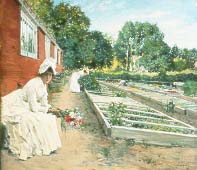
| |
| DON'T PICK THE FLOWERS!--William Merritt Chase's "The Nursery," set in Central Park's flower-frames, on display at Brooklyn Museum. | |
After his protracted—and losing—battle to cut the museum's funding, to dispossess it of its historic building, and dump its priceless collections on Eastern Parkway, its two new art exhibitions could only embarrass him.
They are, in every respect, so thoroughly American, so supportive of Family Values, Civic Responsibility, and the Good Life, that he could only feel shame for the invective he heaped on the BMA and its trustees and staff for the controversial "Sensation" show last fall.
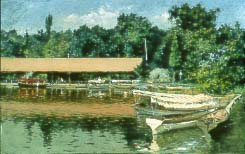
| |
| PROSPECT PARK VICTORIAN BOATHOUSE--Featured in Brooklyn Museum's current William Merritt Chase exhibition. | |
Looking at Chase's impressionist views of city parks and shores, it's difficult to realize that they were once so attractive, safe, and well kept. It's also surprising to discover that scenes in Central Park are not, in fact, Manhattan images.
Frederick Law Olmstead and Calvert Vaux laid out Prospect Park in Brooklyn, as well as Central Park. So what seems a view of a familiar wall and walkway in Central Park is actually across the East River in Brooklyn.
And, as Curator Barbara Dayer Gallati discovered, some Prospect Park scenes were not painted there, but are instead views of Tompkins Park. Today, this is called Von King's Park, located in the Bedford-Stuyvesant district of Brooklyn.
Anyone who has smelled the Gowanus Canal on a hot muggy day will be surprised to see how inviting and peaceful Gowanus Bay was ten years before the 20th century.
But, as Barbara Gallati points out in her excellent study of Chase and his work at this time, these park scenes are not quite what they may seem. Chase may well have been improving on the social actuality of the parks, making them seem much more inviting and refined for people of manners and means.
Handsome Victorian ladies and their children quietly enjoy the landscaped "naturalness" of Central, Prospect, and Tompkins Parks. Nowhere is there evidence of the underclass, or rough & tumble and downright bad behavior.
Well, almost nowhere. In one curious canvas, a young woman in a white dress and cap is sitting by the nursery beds in Central Park. These growing-frames were not on the main paths of the park, so Chase was going behind the scenes.
What's more, no one was permitted to pick flowers in the park. Nor, at that time, even to bring in a bouquet of cut flowers from outside the park!
So this pert girl—who is looking down at the foreground—has broken either of those two rules. Her forward-slouched posture, elbows on thighs, was also not lady-like. She could very well be a servant-girl on her day off.
In contrast, when Chase painted his lovely wife on a folding-chair in the park, this handsome but haughty lady held herself and her fan with an easy dignity, looking toward the right of the picture-plane. She is relaxed, but not lax or casual.
And she does not make eye-contact with the viewer of the painting!
The admirable catalogue—with its many full-color and b&w illustrations—provides a provocative examination of the differences between Manhattan & Brooklyn actualities and the scenes Chase painted and sketched at this period.
Old photos of the parks, of the Brooklyn Navy Yard, and period prints from popular publications show what life was really like then.
Barbara Gallati's commentaries, both on the artworks and their subject-matter, reveal a lot about the two cities that may be very surprising for those who think they know Brooklyn and Manhattan well.
But then, as the late novelist Thomas Wolfe once famously wrote: "Only the dead know Brooklyn."
As Gallati emphasizes, in the exhibition and the catalogue text, Chase's choice of these park and public-area scenes was a deliberate attempt to defuse charges of American art critics that he was still too bound to European styles and subjects, thanks to his years of study in Munich and elsewhere in Europe.
His strategy succeeded. In this five-year period, he was able to re-invent himself as a painter of American scenes and life. As Gallati notes, these views were the first Impressionist works ever painted of American landscapes.
This exhibition travels to the Art Institute of Chicago [September 7] and Houston's Museum of Fine Arts [December l3].
The catalogue, like this show, is titled: William Merritt Chase: Modern American Landscapes, 1886-1890. It is authored by Barbara Gallati, and has 124 illustrations, 54 in full color. At 192 pages, it costs $37.50.
Anyone—not only New Yorkers—who loves this city will want to own this handsome volume.
Maxfield Parrish, 1870-1966
[Closing August 6]
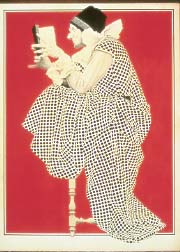
| |
| MAXFIELD PARRISH'S "THE IDIOT"--Elaborate detail of fantasy artwork on display at BMA. | |
They show to far better—and uncrowded—advantage in the spacious fourth-floor exhibition galleries of the Brooklyn Museum.
What's more, arranged by themes or subject-matter, they are hung against bright pastel walls which bring out the best in their bold colors.
If William Merritt Chase avoided the harsh underside of Manhattan life in his park scenes, Maxfield Parrish often avoided even pleasant mundane realities, in favor of a wildly Romantic Vision of castles in the air and never-never-land vistas.
The business of daily living was usually clothed in quirky medieval metaphors or fairytale-cute costumes. Parrish's People were either lovely ephebes or gnarled peasant caricatures.
Even his vistas of rustic landscapes, with quiet candle-lit homes, make Norman Rockwell's similar scenes seem brutal by contrast.
No wonder Parrish's images, as posters and calendar-art, have never really gone out of fashion.
Nonetheless, at the time the Parrish show was at the Academy of Fine Arts, the owners of the historic Curtis Building had applied for permission to destroy the remarkable Parrish/Tiffany iridescent glass-mosaic landscape mural in the entrance foyer of that august structure!
Even in his own time, Parrish had some difficulty being perceived as a real artist, and not just a clever illustrator-craftsman. It remained for a distinguished British art critic to perceive the genius in Parrish's combination of Pre-Raphaelite fantasy and photographic reality.

| |
| A GNOME FOR SNOW WHITE: Max Parrish's cutout figure for unrealized stage-production of "Snow White & Seven Dwarfs." | |
I grew up on Parrish's wonderful neo-classic fantasies and fairytale images. Yes, they are overwrought and impossibly unreal.
But they were then a necessary refuge from the harsh actualities of farm-life during the Great Depression.
Perhaps I'd admire Parrish's artistry more had he created his fantasies directly from his imagination onto his canvases. In fact, he had archives of images of clouds, trees, cliffs, castles, and costumes.
For a placid night-time rural scene, he constructed an elaborate scale-model of the house and barns.
To paint a lovely young female nude, bending over, he photographed himself nude in the same pose, tugging on a string attached to his camera-shutter.
Even with this architect's and anatomist's attention to detail, Parrish still couldn't avoid either idealizing or caricaturing his people, palaces, and places.
Some of the most handsome and mysterious paintings in the current show are made even more so by the gradual darkening of their images. Some are now so dark that it's extremely difficult to see the details.
Parrish added to the decorative unreality of his works by coating them with several layers of glaze and varnish. Over time, this has darkened badly on some.
As with the Chase show, there is also an excellent, wonderfully illustrated catalogue accompanying the Parrish exhibition. I bought my own copy in Philadelphia last fall, but someone has taken it, so I cannot share its details and specifics.
Be assured you can get it and many, many Parrish posters and postcards in the BMA shop!
The projections for this new space-sculpture and modern art showcase are the work of that most avant of avant-garde architects, Frank Ghery. And they are inspired by the success of his wildly innovative Guggenheim in Basque Bilbao, in Northern Spain.
As wall-texts note, in the few years the Bilbao Guggenheim has been open, some $400 million of trickle-down tourist and other income has engulfed the previously out-of-the-way city.
Why else would anyone want to go to Bilbao? If culture vultures know it at all, that's because of Bertolt Brecht's "Bilbao Song," with music by Kurt Weill.
Obviously, Manhattan doesn't have Bilbao's recognition problems. And it already has two Guggenheim Museums, one on Upper Fifth Avenue, the other downtown on Broadway in SoHo.
But the Museum's dynamic and visionary director, Thomas Krens, is something of a Museum Empire Builder. In addition to Peggy Guggenheim's Venice Museum, there's now also a Guggenheim in Berlin on the Unter den Linden, no less!
Krens has at least twice been turned down by the Citizens of Mozartian Salzburg on his proposal to install an Austrian Guggenheim inside the city's signature Fortress Mountain, the Mönchsberg.
But, given his persistence, he may yet succeed. There's already a parking-garage carved out of the living rock—as well as part of the Salzburg Festival Theatre!
It's reported that Mayor Giuliani and his aides hate the new proposal. But it is so unusual, exciting, and dynamic, that the Ghery/Krens proposal may well carry the day, supported by cultural leaders and art critics.
If constructed, it will certainly revitalize the Lower East Side and the Wall Street area in a way that South Street Seaport has not yet been able to do.
But—as with the Parrish show at the Philadelphia Academy of Fine Arts—the Victorian spaces of that august building proved far too cramped for the size and number of canvases depicting the various subjects or themes around which this provocative show is organized.
Oddly enough, even though the Frank Lloyd Wright spiral ramp is an enemy to square or rectangular pictures hung in downward—or upward—procession, these turn-of-the century canvases stand out on the slanted walls.
One reason is certainly their own boldness, but also the ornate old-fashioned framings of many of the paintings make them stand out even more against the warm neutral background colors.
It is almost a surreal vision to look across at the opposite spirals and see the progression of academic art and early modernist works in this ultra modernist milieu.
To give modern viewers some idea of how such artworks were hung at the Paris Exhibition of 1900, two rooms attempt to recreate the aura of plush and velvet and walls crowded with paintings.
It was certainly an unusual idea to attempt to recreate a broad sampling of the art shown at this Jahrhundert-Wende exhibition. An Artistic Intersection of Academic Salon Art and Modernist innovations.
Some of the current works were shown a century ago. Others from that show were destroyed in wars or otherwise lost.
But similar works by those artists have been substituted. Other artists did not show in 1900, but their works included now give a very good idea of the broad spectrum of subjects and styles offered fin de siècle spectators in the shadow of the Eiffel Tower.
New York viewers will of course find many now canonized Modernist artists on view. But they may be surprised to discover other artists, painting similar subjects, often with equally masterful techniques.
On a recent visit to Paris' Musée d'Orsay, as well as to the Fauvist show, I was surprised to find important works by French and other European artists totally unknown to me. Both the paintings and the artists!
In some cases, the artists' work was limited, or it was almost entirely bought by European collectors and museums. Rather than by America's Robber Barons and their baronet progeny.
Some of the works and artists now on view will surely spark future special exhibitions on this side of the Atlantic. Especially some of the almost unknown Scandinavian painters, notable for their "Northern Light."
But there is also a fair amount of opportunistic and moralistic Kitsch in this show. Bulging bank-accounts did not necessarily signify alert artistic intelligences. So some obviously talented artists painted what they knew would sell.
Nonetheless, Léon Fréderic's wide triptych, The Stream, is so surreal and bizarre that he surely did not concoct this photo-realistic Symbolist vision of hordes of bare-assed little children swarming in torrents of water for the popular market.
Frankly, it's refreshing to see paintings and sculptures shown in relation to their diverse treatment of similar themes and/or subjects. Rather than by Schools and Movements.
In some cases, you can see immediately why some names have become ikons. And others forgotten. But you also see works by artists who did not deserve to descend into virtual oblivion.
New discoveries of old artworks for everyone. Get the catalogue!
This time it's the Düsseldorf Academy, featuring such historic talents as Wilhelm von Schadow, Johann Wilhelm Schirmer, Oswald Aschenbach, and Arnold Böcklin.
Johann Wolfgang von Goethe's writings about his famous travels in Italy were an impetus to German painters to travel far south of the border. Instead of painting in dank German studios, they were sketching and painting, in plein air, the warm landscapes of Italian hill towns near Rome.
But the Dahesh needs a new home for this. The old/new Huntington Hartford Gallery of Art on Columbus Circle may be just the place. But it's rumored that the Mayor is not keen on this solution to the City's abandonment of the structure.
Nor, apparently, is he fond of Frank Ghery's proposal for Manhattan's own Titanium-Flounced version of the Bilbao Museum down at South Street Seaport.
Now that the Mayor is a changed man, more humane, perhaps he'll change his mind about New York Museums and their needs and wants?
For the Record, here's a letter and some notes on the Dahesh I recently sent to the Landmarks Commission, on behalf of the hated Hartford Gallery and the desperate Dahesh:
The Honorable ennifer Raab, Chairperson
LANDMARKS PRESERVATION COMMISSION
100 Old Slip/New York/NY 10005
Dear Chairperson Raab and Members of the Commission:
May I add my voice to the chorus of concerned citizens who want the former Huntington Hartford Art Gallery on Columbus Circle given Landmark designation?
While it is true when it opened that this innovative and imaginative building was derided by some then-reigning architectural taste-makers, at the same time, there were a number of knowledgeable experts who found much to admire about its conception and the use of its extremely awkward and limited parcel of land.
At that time, influential critics were still in the thrall of the nternational Style, whose continual erosion on major drafting-boards has given Manhattan some of the ugliest high-rises in the world. These architecture-mavens could not have known that Edward Durrell Stone's design for Columbus Circle would prove the harbinger of Post Modernism, as developed by Michael Graves and other innovators.
Some regarded the Hartford Gallery as a retro recycling of Renaissance Venetian Palazzi. It was, in fact, a most ingenious adaptation of some historical Venetian design idioms, well before Michael Graves had begun recycling Renaissance Tuscan architecture as a new vision, a sort of Post Modernist Art Deco.
I believe Stone's unusual building is an important landmark in the development of Post Modern Architecture, not a retro throwback because he had run out of ideas. Nor was it a cruel joke on art-lovers, as some have insisted.
"No Windows!" was an often-heard complaint, mainly from those who hadn't been inside. Or who did not remember that an art-gallery needs blank wall-space on which to hang pictures. And that such a structure also doesn't need windows, nor direct sunlight falling on priceless paintings.
Part of the initial problem about the Gallery's reception was the fact that it was effectually "willed" to exist by Huntington Hartford. His legendary millionaire whims and tastes were often derided, including his reputation for losing interest in projects which did not meet with immediate acclaim or success. I once wrote for a performance-oriented magazine he founded, so I know something of his grand inattention to details.
For some irate critics of the building, it was doomed from the outset by the very fact of its association with Hartford. And with his art collection and taste, which were not widely admired.
It's true that the exhibition floors are not grand in scale, nor are they of conventional dimensions—owing to the land on which they stand. But this should prove no obstacle to an organization such as the Dahesh Museum, which would like to restore the now shabby, surface-stained building to its initial glory.
In addition to urging the Landmarking of Stone's historic structure, I'd like to add a plea for the Dahesh Museum as an excellent occupant. I have been following the fine exhibitions the Museum has been mounting on Fifth Avenue. These have, however, been limited severely by the small space available and the often grand scale of some major Salon paintings.
The Dahesh Collection itself—and the important works the museum has been able to borrow for its specially-themed shows—are important examples of 19th century academic art, unknown to many New Yorkers. These works and their styles and themes—beloved of wealthy Victorian collectors on both sides of the Atlantic—have long been out of favor. So much so, that many once-admired paintings have been in storage at major museums for years. It's time for Academic Art to come out of the closet.
It would add another gem to Manhattan's Museum-Crown to have a handsome and historic space specially devoted to major and minor Salon paintings. The City of Paris converted its historic Gare d'Orsay railway-station into just such a magnificent museum!
The Metropolitan Museum does show some of its Salon treasures—such as Rosa Bonheur's The Horse Fair—but usually only in the long second-floor corridor leading to more Modern Art. The Dahesh Museum, relocated on Columbus Circle, could do much better than that. I have appended some comments I've made for my column, Curators' Choice, online on the website: New York Museums.com
Considering the great bulk of the former Gulf & Western Building across the Circle—not to mention the even greater bulk of the new center to be constructed on the Coliseum site—demolishing the Gallery to construct more Trump-Style Luxury Apartments seems almost obscene.
New York does not need more high-rise, high-rent buildings for the privileged few. On Columbus Circle, it needs instead a handsome, if idiosyncratic, Art Museum, whose elegance and grace will prove a welcome visual contrast to the Post Modernist Elephantiasis on 180 degrees of the Circle.
Thank God for the Maine Monument! Remember the Maine! Remember Stone's Post Modernist Art Deco Venetian Palazzo! Please, let us retain some variety and history on Columbus Circle!
Or should we also replace that venerable statue of Cristoforo Colombo with one of The Donald?
Anyone wishing to contact the Dahesh [at 601 Fifth Avenue, NYC 10017], phone: 212-759-0606. FAX: 212-759-1235. Or e-mail: information@daheshmuseum.org
[Loney]
Copyright © Glenn Loney 2000. No re-publication or broadcast use without proper credit of authorship. Suggested credit line: "Glenn Loney, Curator's Choice." Reproduction rights please contact: jslaff@nymuseums.com.
Bilbao on the East River?
Frank Ghery's Proposed New Guggenheim:
Actually, the broad flourishes of silver metal ribbons swirling over the models of the proposed East River Guggenheim—now on view in their own room at the FL Wright uptown Guggenheim—are intended to be "a cumulus cloud" of titanium, supported by the more conventional structures which will house the exhibitions.
Titanium Spirals Below South Street SeaportVertigo on the Guggenheim Spiral Ramp!
Academic Art on Walls Made for Kandinsky! Paintings from the Paris Exposition:
[Closing September 10]
In February, I saw this astonishing show in London at the Royal Academy of Art.
1900: Art at the CrossroadsAt the Midtown Dahesh Museum—
In the Footsteps of Goethe:
[Closing August 19]
While the Super-Modernist spiral of Frank Lloyd Wright's Upper Fifth Avenue Guggenheim Museum is only temporarily host to a host of unfamiliar turn-of-the-century Salon Paintings and innovative Modernist experiments, the intimate one-room Dahesh Museum—on Fifth Avenue and 48th Street—is awash in Academic Art.
Paintings and Drawings from German CollectionsMove the Dahesh Museum To Columbus Circle!
Unlike the Guggenheim, which is usually dedicated to Modern Art and Beyond—including the occasional Motorcycle Show and Armani Fashion-Show—the Dahesh is only interested in giving 19th century academic painting a new chance to be seen and savored. Even disputed.